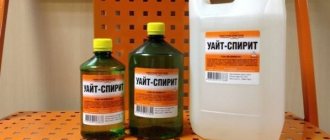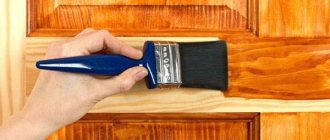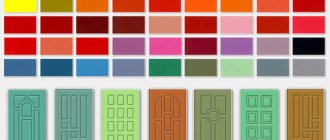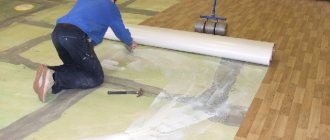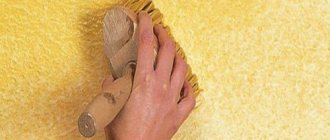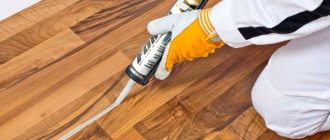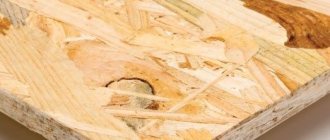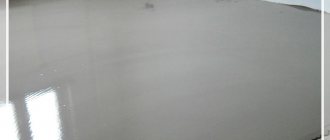Often when renovating a room, especially cosmetically, the question arises: restore the old floor covering or replace it? Of course, from a budget point of view, it will be more profitable and practical to tidy up the old floor. And what to do if it is covered with linoleum? In this article we will look at the simplest option - painting it.
Painting linoleum
So, is it possible to paint linoleum? Many experts view this negatively. Of course, it is more profitable for them to receive an order for a complete replacement of the old coating. But practice shows that it lends itself perfectly to painting.
Types of paints
Oil paint. Oil-based paint compositions have excellent adhesion and increased durability. Among all paint and varnish compositions, oil-based ones adhere to the surface much more effectively.
Oil-based paint compositions have excellent adhesion and increased durability.
Linoleum coating is easily processed with this composition, is a quick-drying product and has low toxicity.
Butyl rubber and chlorinated rubber enamels. This type of paint creates a durable yet soft coating, but the work will require special surface preparation. In addition, grease and oil stains may remain on the enamel. The complete drying period is 24-30 hours, the paint belongs to the budget price category.
This type of paint creates a durable yet soft coating.
Alkyd, polyurethane and alkyd-urethane compositions. This type of coloring compositions is a high-quality and expensive product. The coating is highly durable and hard.
This type of coloring compositions is a high-quality and expensive product.
Acrylic paints and varnishes. Using acrylic paint you can make the coating tough and durable; it is excellent for commercial linoleum.
Using acrylic paint you can make the coating tough and durable.
In the process of updating the linoleum covering, you may encounter the problem of accidental staining or contamination of areas that should not be painted
It is important to remove the paint so as not to damage the material. Any stain can be wiped off with a napkin or a clean cloth, but only if this is done immediately; if the contamination was not removed in a timely manner, then the dried paint will have to be removed in other ways
We invite you to read: Decorate the garden with your own hands from scrap materials
Cleaning methods:
- Mechanical method. Stains are removed with abrasives;
- Chemical substances. Special chemical compounds are used.
The most suitable cleaning chemicals are:
- Acetone;
- White Spirit;
- Special composition for removing construction paints and varnishes.
Acetone is one of the most effective and at the same time most dangerous substances.
We paint it ourselves
The painting process has always been considered one of the simplest technological activities. Painting linoleum is difficult and time-consuming, so you must at least be patient. After applying the paint, all defects and problem areas of the linoleum will be clearly visible, so approximately 2/3 of the working time will have to be spent on repairing and cleaning the floor covering.
A relatively new floor can be varnished
Preparation of linoleum
It is clear that before applying paint, the surface must be repaired. All holes and cuts are sealed with epoxy compounds, putties and primers, rubbed and polished to a shine. Sometimes the finishing procedure has to be repeated in order to finally get rid of the protruding repair layer.
Coloring rules
Coating of products with coloring compounds is carried out according to certain rules:
- The parts must be well dried according to the manufacturing technology.
- After purchase, the elements must be aged at home. It takes at least 1–2 days for the stone to reach a balance of temperature and humidity.
- If previously treated products are painted, they are pre-polished. This is very difficult to do, especially when the products are already on the walls.
- Impregnations are used according to the recommendations that each manufacturer indicates on the label. Some are applied before painting, others after. Some options are not compatible with coloring compounds.
Paint, tools and techniques for painting linoleum
Consistency is a quality that is certainly appreciated by each of us, only sometimes changes are for the better. For example, at times there may be a strong desire to change something in the apartment.
However, there is no extra money for expensive new things and good repairs, as always happens in such cases. Then it’s better to either minimize the changes by moving furniture or buying new curtains, or go further and afford yourself a little more.
Painted linoleum takes on a new life, it looks like new
Perhaps this does not immediately come to mind and even seems a little wild, but why not start painting linoleum, which has already become fairly worn out and lost its appearance? One can only be amazed at how much this can transform the interior of a room or apartment as a whole! But how and with what should you paint linoleum in order to achieve the highest quality result if the repair is carried out at home and by a non-professional?
With the intention of understanding this issue and receiving useful step-by-step advice, first of all, you need to consider what linoleum is and what advantages and disadvantages it has.
How to paint linoleum at home
First of all, you need to follow the sequence of work. This means you immediately need to prepare the surface for painting. Only after this we will apply paint. It also doesn’t hurt to stock up on the necessary supplies in advance. So as not to run to the store during the dyeing process. And remember, there should be no swelling or waves on the linoleum.
To paint linoleum you need the following tool:
- Bucket of water, detergent, rag and mop. Remember to paint on a clean surface;
- Accessories for repairing old linoleum. In case of holes and tears;
- Medium grit sandpaper. For treating the top coat layer to improve adhesion;
- Primer and varnish, in case of using acrylic paints;
- Select and buy paint for linoleum based on the above requirements;
- A special tray or tray for paint. This will make it more convenient to paint;
- Paint roller to ensure even distribution of paint. Don't forget to buy a brush too. It is useful for hard-to-reach places;
- Painting tape to cover the baseboard without removing it.
Step-by-step instruction
Now let’s figure out how to properly paint linoleum with your own hands. I advise you to decide on the color in advance. This can be a monochromatic design, a 2-color striped pattern, or the use of a beautiful stencil. After choosing the shades, we begin the work. Read these step-by-step instructions carefully.
The first step in preparing the linoleum surface is cleaning it. If it's a kitchen, there will be a lot of dirty, greasy stains on the floor. It is necessary to wipe them off so that the paint lays evenly and adheres well. There are also a lot of stains, stains and debris in the toilet and bathroom. Fairy is good for cleaning floors.
The second step is to thoroughly inspect the floor for tears and damage. It is imperative to repair holes in the linoleum. This will make the new floor look nice and prevent the paint from peeling. For repairs you will need a patch, cold welding (best) or liquid nails and double-sided tape.
The third stage is treating the linoleum surface with sandpaper. As already mentioned, medium-grit sandpaper is sufficient. There is no need to rub hard and completely remove the top layer. It is enough to lightly walk over the entire surface of the floor. This will allow you to remove solid debris and sand. The surface will become slightly rough, which will significantly improve adhesion to the paint.
Step No. 4 - if you use acrylic paints, be sure to prime and degrease the surface after sanding. This way the paint will adhere better and more evenly to the surface.
Fifth stage – we paste masking tape over the baseboard so as not to stain it with paint. You can remove your baseboards and not have to deal with tape. In general, do what is most convenient for you.
Step six - you can start painting the linoleum. To reliably paint over the old pattern, it is better to apply 2 layers of paint alternately. This means we apply the second layer only after the first has completely dried. This way we will completely eliminate the possibility of the pattern showing through.
Important! If you are planning a two-tone striped floor, after applying 2 coats of the first "base" color, wait for it to dry. Next, cover the surface with strips of tape at the required width from each other.
For accuracy, it is better to measure this width in advance so that it is the same. Then feel free to apply paint between the strips of adhesive tape. When the floor is dry, carefully remove the tape. The result will be a beautiful, uniform and clear pattern.
In the case of a stencil, it is better to use a square shape. This will make it easier for you to apply a pattern to the surface of the linoleum.
Well, then we wait for the paint to dry
Pay attention to the complete drying time, it is indicated on the can. Only after this can furniture be brought in so as not to spoil the surface
The last step is when using acrylic paints, after drying, the surface is covered with one or two layers of varnish. Be sure to do this so that the paint does not peel off later. A regular varnish based on the same acrylic is suitable.
Don't be afraid to paint old linoleum a different color. Painting actually doesn't take that long. Start your work in the morning and use quick-drying paint. This will allow you to complete the coloring by the end of the day. Sometimes, depending on the type of paint, you need to wait a few more days. This is necessary for the surface to acquire final strength.
Types of varnish for linoleum
Of modern paints and varnishes, only four types of materials can be offered for experiments with restoring linoleum:
- Ship or yacht varnishes are urethane-based; they provide a very durable layer and are resistant to moisture, but to obtain gloss, additional treatment of the linoleum surface with polish will be required, since the intrinsic gloss of such a material is approximately “C.” At the same time, the linoleum itself must be unlined and over 10 years old;
- Special water-based varnish V33 Vitrificateur Renovation made in France;
- Oil-wax polishes used to restore coatings on unstable and overdried wood;
- Conventional acrylic compositions for parquet and laminate.
Old high-density linoleum can be coated with pure urethane varnish from any manufacturer.
Important! But often such varnishes cannot be applied to linoleum in a thin and even layer to avoid stains and defects.
Therefore, linoleum is coated either with oil varnishes or wax polishes, or instead of colorless mixtures it is necessary to use “dull”, opaque, tinted ones. For industrial and office premises, a situation in which linoleum is coated with varnish of a certain blue or green color can be considered a completely acceptable solution; for apartments and private houses, only transparent or translucent material should be used.
Unusual coloring of a plaster product
There are ways to paint plaster with your own hands, which allow you to achieve an interesting look for the surface, including aging.
Under old marble
Process algorithm:
When making it yourself, the stone is thoroughly dried; the temperature should not exceed 55 degrees at the last stage of drying. The purchased product is aged for 48 hours in a warm room. Next, heat the drying oil
You must be careful and wear gloves when working. A flute brush is used for application. The surface is impregnated in two layers, all areas are treated with special care to avoid gaps. Over time, the elements will take on a look reminiscent of old marble.
In addition, such impregnation reduces the hygroscopicity of gypsum.
Under terracotta
The technology is almost identical to the previous version, but the coating composition is shellac varnish and rosin, which are diluted in industrial alcohol.
After a certain period of time after applying the composition, the surface becomes similar to terracotta.
A mixture of shellac varnish and rosin produces brown plaster.
Creating a bronze sheen
The technology requires the availability of the necessary ingredients and the following steps:
- Plaster figures are well soaked in drying oil and laid to dry for 8–10 hours.
- Bronze powder is prepared, diluted in varnish. Products are treated with this composition in two layers.
- The material dries well.
- A mixture of silver nitrate, acetic acid and water is prepared. Proportions: 10 g of silver, 100 g of vinegar and 300 g of clean water. If required, pigment is added.
- The product is coated with a thin layer of bronze powder and treated with a solution on top. Oxidation occurs.
- The surface is wiped well with a piece of velvet.
Using stain
Stain is used quite often. It can be applied well with a spray gun, but the best results are obtained when completely immersed. To do this, the composition is slightly heated, the parts are dipped for a short time (5 to 10 seconds) and immediately sent to dry. If required, the fragments are pre-wiped.
It might be useful to read:
- Mass specialized E-Mail mailing service;
- Leaders in protection against ddos attacks;
- How to connect to open ports How to connect to open ports;
- How to connect to open ports? ;
- What Windows services can be disabled to speed up the system;
- Installing Kali as an additional operating system on a Windows computer;
- Unity Web Player: what is it for and how to use it? ;
- Department to the police department. Structure of the Ministry of Internal Affairs of Russia. Structure of departments of the Ministry of Internal Affairs. System elements of the Main Directorates;
Preparatory stage
Before painting linoleum, you should treat it with a damp cloth to remove dust and dirt. Further preparation should be performed in this order:
1. Remove protective wax from the floor covering. This is quite easy to do. Add a glass of soda to a bucket of warm water and wash the floor with this solution. To avoid delaying the process, use a brush. Wash the floor clean. Let the surface dry completely.
2. If there are cracks or torn areas on the linoleum, treat them with a thin layer of putty. After complete drying, apply an acrylic primer (you can also use varnish).
Now the surface is ready, you can apply paint.
Paint for linoleum: updating the floor covering the old fashioned way, but with modern means - Floor School
There is an opinion that painting linoleum is not a very good idea: the paint does not adhere well, lays down in an uneven layer, etc. In fact, oil paint (meaning ordinary floor paint) adheres to this coating much better than on a plank floor.
High quality floor paint from
What paints can be used when working with linoleum
Alkyd enamel from Macrofab is a fairly popular material on the Russian market.
This type of paint is successfully used for painting metal and wooden surfaces; therefore, it is perfect for outdated, discolored linoleum.
- Alkyd enamel resists moisture well, as well as exposure to light;
- The paint is universal, durable, and ideal for painting metal and wood surfaces:
- stairs,
- fencing,
- frames.
The Macrofob assortment includes alkyd enamels of the following models:
- ML-1110;
- AS-182;
- ML-165;
- PF-133;
- PF-115;
- MS-160;
- MS-17 and others.
).
Alkyd enamel
Alkyd enamel from Macrofab is a fairly popular material on the Russian market.
This type of paint is successfully used for painting metal and wooden surfaces; therefore, it is perfect for outdated, discolored linoleum.
- Alkyd enamel resists moisture well, as well as exposure to light;
- The paint is universal, durable, and ideal for painting metal and wood surfaces:
- stairs,
- fencing,
- frames.
The Macrofob assortment includes alkyd enamels of the following models:
- ML-1110;
- AS-182;
- ML-165;
- PF-133;
- PF-115;
- MS-160;
- MS-17 and others.
What to choose for painting a linoleum floor
Before you go shopping for paints and varnishes, you need to decide on the color and future texture of the surface. It is clear that painting linoleum can be perceived by many, including sellers, as a last resort in the absence of funds.
In fact, the practice of restoring a PVC coating with paint is a fairly subtle and effective operation, the result of which can be very impressive. You just need to choose the right material for linoleum and strictly follow the paint application technology.
This type of floor is easier to paint than to clean.
We draw attention to two main points:
If there is simply a reference to the fact that paintwork materials can be used as paint for linoleum coverings, then it is better to refuse in favor of a specialized coloring composition. For example, acrylic paint can be used to paint PVC, but after drying it produces a fairly hard layer. For a linoleum floor, you need a paint and varnish composition that simultaneously has great adhesion, good ductility and wear resistance.
Cleaning linoleum from excess paint
So, when we figured out whether linoleum can be painted, we need to talk about the rules of painting that relate directly to its application
The problem is that when applying the substances described above, the floor may be contaminated due to carelessness. We will talk about how not to damage the coating and eliminate defects that arose during the application of paints and varnishes.
Any blot should be quickly wiped off using a napkin or a regular clean rag. If this action was not performed on time, then the dried stain must be removed in a more complex way.
There are two main cleaning methods:
- Mechanically, the stain can be removed by using abrasives (mixtures containing hard particles), which will help scrub the stain off the surface.
- The chemicals will easily dissolve the active ingredients of the paint and varnish material, and then the residue can be easily wiped off.
Mechanical removal is more practical, since chemicals carry the risk of damaging the linoleum or the protective layer on its surface. It is quite possible that after chemical cleaning there will be no stain, but some part of the coating will be irretrievably lost.
The following chemicals are used as cleaning agents:
- White Spirit;
- acetone;
- Construction varnish remover.
Acetone is considered the most effective on this list, but the increased causticity of the substance makes its use not the safest for coating, so you should exercise extreme caution when applying it to the stain and surrounding area. When rubbing a contaminated area, you must apply a minimum of effort so as not to create a defective area yourself.
Cleaning the stain may be more effective if the stain is treated with vegetable oil. Just 2-3 such applications and attempts at mechanical scrubbing may be more reliable than using harmful chemicals.
Thus, before starting work, it is worth finding out not only whether it is possible to paint linoleum and with what paint, but also to familiarize yourself with the basic rules for applying the substance and the features of cleaning the coating from accidental contaminants, so that during visual inspection and in the photo the floors will be beautiful.
Bottom line
From all of the above, it is not difficult to understand whether it is possible to paint linoleum - the professional’s answer indicates the admissibility of such a procedure. As soon as a high-quality paint and varnish material is selected, it is necessary to paint according to the rules given above, and then the quality will be guaranteed. Renewed linoleum will last for many years, regardless of how many years before painting it was laid.
Types of paints for linoleum Alkyd enamel Acrylic enamels Heat-resistant paints and varnishes Preparing linoleum Cleaning linoleum from excess paint
There is a widespread stereotypical opinion among homeowners that painting linoleum is useless and unreasonable: there is no adhesion of paints and varnishes, there is no uniformity of application, etc. However, as practice shows, this is not the case, and the article will discuss how to choose the right paint and apply it effectively.
Is it possible to paint linoleum and how to do it?
Is it possible to paint linoleum? This determines how much it will cost to redecorate your apartment. Replacing rolled flooring can be a significant expense, while painting it will be much cheaper.
Linoleum is a durable material, it lasts for decades and does not lose its properties, but gradually tires the eyes. By painting it, you can update the design of the room and save money.
painting linoleum
Features of paint selection
In fact, the question of whether it is possible to paint old linoleum is most relevant for country houses, various summer kitchens and other similar buildings. There, as you know, temperature differences are quite significant, and the load on the surface is high, since people most often walk on it wearing shoes. The strength of the surface is very important, so the paint must be of very high quality.
Oil formulations
Budget option will save money
A few decades ago this was the only possible composition option.
This group of products is characterized by the following features:
- Low price of paint. Even though the cost has risen significantly in recent years, this option remains the most budget-friendly.
- Good adhesion of the composition to the surface. Organic-based linoleum paint adheres well and transforms the surface.
But there are many more disadvantages:
- A rather pungent odor that lasts in the room for several days. Naturally, it is undesirable to be in it during this period.
- The surface drying time is at least a day, while modern options dry in a few hours.
- Poor abrasion resistance, as a result of which the surface must be tinted at least once a year.
Alkyd-based solutions
It is best to choose special enamel for the floor - it has higher abrasion resistance characteristics
You can often come across the question, is it possible to paint linoleum with nitro paint? Due to the high properties of the composition, this type of work is not only possible, but also preferable to oil solutions. After all, paints are made using more advanced and durable polymer solvents, which make the coating more durable.
The main advantages include the following:
- A very wide range of colors, allowing you to choose the best option for any floor. The colors are very rich and vibrant, and thanks to the use of high-quality components, they remain bright for many years.
- The resulting coating is highly resistant to moisture, so alkyd paints can be used in kitchens and bathrooms.
Among the disadvantages, it is worth highlighting a rather pungent odor and low ductility of the paint layer: if the linoleum is soft, then the surface may crack.
Acrylic paints
Very high quality paint for a wide variety of substrates
Let's figure out whether it is possible to paint linoleum with paint based on acrylic polymers. This group of compounds is characterized by high reliability and good adhesion to most materials. Linoleum is no exception, so you can paint it with acrylic paint.
The main advantages of acrylic compositions are as follows:
- High strength and wear resistance of the surface. The coating retains its properties for many years.
- Excellent surface resistance to aggressive chemical influences.
- There is virtually no smell during the work. In addition, the paint is easily washed off with water, which is also an undoubted advantage.
- The drying time of the floor is only a few hours, which allows repairs to be carried out quickly without leaving the premises.
The only downside is the high price of the composition.
Other coating options
There are other options that are used much less frequently than those described above, although with their help you can create a very durable protective layer with your own hands:
Jobi's ultra-durable glossy paint allows you to create a durable coating that is resistant to abrasion, damage and aggressive chemicals. The instructions for using the composition are very simple, and the results are excellent. But the cost of this option is far from budget.
The coating is so durable that it is called “liquid plastic”
If you don’t know how to paint linoleum in a corridor, hallway or other damp room, you can use chlorinated rubber enamel. This composition is so durable that it is even suitable for swimming pools and terraces.
Chlorinated rubber composition has the highest protective properties
How to paint linoleum on the floor
Today, the choice of paints on store shelves is much wider than in Soviet times. Moreover, modern paints dry much faster. They are less toxic and practically odorless. And the variety of colors makes your eyes widen. But what kind of paint sticks to linoleum?
Requirements for paints and varnishes:
- High adhesion, i.e. the ability to firmly and reliably adhere to the painted surface of smooth materials;
- Increased degree of abrasion, including under the influence of furniture;
- With minimal content of harmful substances and solvents. In order not to harm your health and not damage your old linoleum.
Now let's look at which paint meets these requirements. In fact, there are only 2 types. After which everyone will choose for themselves what is the best way to paint linoleum.
Types of paints:
- Alkyd paints are a modern, improved prototype of old oil and enamel paints. They are made on the basis of alkyd resins, with the addition of coloring pigments, special fillers and solvents (mainly white spirit). They are distinguished by brightness and color fastness, scratch resistance and high adhesion. It is divided into several types. When dry, they sometimes have a specific odor and may turn yellow over the years. The most famous manufacturers are Sniezka, Alpina, Caparol, Jobi.
Specifically for linoleum it is better to use:
- Regular alkyd enamel for flooring or interior work. Modern quick-drying paint. Drying time from 2 to 5 hours. Has high filling capacity.
- Alkyd-chlorinated rubber enamels. According to its chemical properties, chlorinated rubber is resistant to alkalis, acids and alcohols. The chlorinated rubber coating does not allow moisture to pass through and is resistant to mold. The paint dries quickly in 40 minutes to 2 hours. Once dry, it is highly resistant to impacts and scratches. For example, JOBI Flussiger Kunststoff - “Liquid plastic”, or Sniezka Supermal - Chlorinated rubber enamel.
- Alkyd-pentaphthalic enamels marked PF – 115 (for external use), with PF – 266 (for internal use). This is a classic representative of oil paints. The cheapest option for the price. Drying time from 5 to 24 hours. The enamel is resistant to abrasion and temperature changes, and has very high adhesion to linoleum.
- Acrylic paints . The binding element, the base, is acrylic resin. Acrylic is a synthetic material, so-called plexiglass. To increase elasticity and resistance to external factors, the composition contains diluents (water and solvent). As a rule, acrylic paints are more expensive than alkyd paints, sometimes even 2 times more expensive. They are odorless, and uncured paint can be easily washed off with water. Acrylic enamel dries quickly. The paint has high adhesion to PVC materials and high scratch resistance after drying. Does not turn yellow over the years. The most famous manufacturers are Sniezka, Alpina and Caparol.
Is it possible to paint linoleum with water-based ? Yes, you can, but after painting the surface will have to be additionally varnished . Regular parquet varnish will do. Since even after drying, such paint is washed off with water over time.
Also, when using acrylic paints, the linoleum surface must first be primed.
How to paint linoleum flooring to make it last longer?
With the help of painting, you can not only update the linoleum coating, but also hide minor defects that appeared on it during operation. If you paint a linoleum-covered floor a different color, the room will sparkle with new colors. The main thing when working is to properly prepare the work surface, choose a paint composition suitable for this type of coating and follow the rules for its use.
Preparation: repair, cleaning, sanding, priming
Preparation is the most important stage of painting linoleum. The result of the work depends on how thoroughly the work surface is prepared. Ignoring this step will result in the paint not adhering well, drying unevenly, and peeling off quickly.
The preparatory stage includes the following operations:
- Cleaning the floor from dust and dirt.
- Removing protective wax. It is better to do this with a solution prepared from warm water and a glass of soda. It is more convenient to clean off the protective layer with a brush. After this, the floor covering must be thoroughly dried.
- Elimination of minor defects in the form of cracks and cuts. They can be treated with a thin layer of putty. Broken joints must be sealed with acrylic sealant.
- Sanding. The procedure must be performed with medium-grain sandpaper. You don't have to use a lot of force, just lightly walk over the entire work surface.
- Primer. After the putty has completely dried, the working surface must be primed with an acrylic primer. Varnish can be used as a primer.
Paint selection
To paint linoleum, you can take:
- Alkyd paint. It has a high-quality composition and a wide color palette, it dries quickly, is easy to use, and forms a coating that is resistant to mechanical stress, ultraviolet radiation, moisture and sudden temperature changes. The main disadvantage of this coloring agent is its pungent odor.
- Acrylic paint. This is one of the most durable paint and varnish materials. It adheres perfectly to the surface being painted, increasing its resistance to abrasion. This composition is easy to apply, does not emit toxic substances and dries quickly.
- Oil paint. If you have a limited budget, this option is the most preferable. This paint and varnish adheres well to the prepared surface, applies evenly, and when used correctly does not leave streaks. At the same time, oil paint has many disadvantages: it takes a long time to dry, has a strong, persistent odor, and peels off quickly.
- Heat-resistant paint. Allows you to give the linoleum coating heat resistance. It is better to paint the floor in the kitchen or bathroom with this composition.
The shade of the paint is also important. It should be in harmony with the interior of the room
It should also be taken into account that one of the most frequently soiled surfaces in the house is being painted. It is not recommended to paint it white or other light shades.
What tools are needed?
To work you will need the following tools:
- paint roller with a long handle;
- brush for painting hard-to-reach places;
- masking tape to protect baseboards from accidental paint if there is no desire or opportunity to remove them;
- tray or tray for paint and varnish;
- rubber gloves to protect hands from paint;
- a respirator to prevent poisoning by vapors of the coloring composition;
- an old robe or apron.
Painting linoleum
To paint old linoleum flooring, you need:
- Cover baseboards and wall-to-floor joints with masking tape.
- Pour the coloring composition into the tray and, if required by the manufacturer, dilute it with a solvent. Mix the components thoroughly.
- Paint the surface. Start work from the corner farthest from the door. The paint must be applied in an even layer. Cover the surface in one approach. You should not paint the floor in parts, otherwise transitions will be visible on it.
- Apply a second coat if required. Subsequent layers are applied only after the previous ones have completely dried.
- Cover the work surface with varnish. You can varnish in one or two layers. This prevents the paint from peeling off.
Recommendations for coloring
So, you have everything you need at hand to begin the painting procedure: the right can of paint, working tools and creative enthusiasm.
Painting linoleum, as well as pre-treatment, is divided into several main stages:
- Painting tape is applied along the entire perimeter of the wall to protect it from accidental painting. By the way, with the help of this tape and or stencils you can easily feel like a designer, for example, dividing the floor into stripes or creating your own unique design.
- Dilute the paint with solvent and mix thoroughly. Pour into a tub or tray.
- Painting begins in the direction from the far wall to the door. Wait for the paint to dry completely.
- Apply a second coat. Wait until dry.
If you closely adhere to all the above recommendations, the paint on the linoleum will only need to be updated if your soul asks for new changes.
Painting linoleum is an undertaking that only at the beginning seems doomed to failure, but in the end it turns out to be an economical find for the thrifty owner. This way out of the situation will help to update the old linoleum, and with the proper design approach, it will make it a real decoration of the apartment. Overall, the game is worth the candle!
How to paint linoleum
Selecting the right materials is almost half the success of all work. The ideal paint for such work should have:
- High degree of adhesion to planes with low roughness.
- Good resistance to mechanical damage, that is, to abrasion.
- Keep the content of organic solvents as low as possible, as they can contribute to corrosion of the surface under the paint.
Fortunately, these parameters correspond to as many as four types of consumables: enamels, alkyd-chlorinated rubber and alkyd pentaphthalic, liquid plastic and, of course, oil paints.
Enamels are highly resistant to moisture and are also much more durable. They are not as cheap as regular paint, but most often it is better to pay a little extra for quality. In addition, the enamel dries faster and does not smell of toxic fumes.
The so-called liquid plastic will be one of the best materials in terms of quality. It is durable and resistant to damage. However, the plastic hardens for a very long time and is by no means cheap.
Which colors to choose
The choice of paint for linoleum depends on the required drying speed, the degree of wear of the coating and the required durability.
Alkyd paints
Alkyd resin paints and pigment additives are an improved type of old oil-based coatings and enamel. They have gained popularity due to their brightness and color stability, high adhesion and durability. Disadvantages include the appearance of yellowness over time and a pungent odor when performing work. There are several types of alkyd compounds. For linoleum it is better:
The layer must be applied to a previously prepared surface. Durable enamel can be used to cover stairs, supporting structures, fences and other decorative elements.
Acrylic paint compositions
Acrylic is a synthetic compound, otherwise known as plexiglass. Such options are much more expensive than alkyd ones, but they do not emit a toxic odor, and the uncured composition can be easily washed off with water. Acrylic dries quickly and has high adhesion to PVC surfaces, so it is immediately absorbed. The material does not turn yellow over the years and withstands scratches, impacts and other threats of abrasion.
Oil paints
In austerity mode, linoleum can be painted with oil-based compounds. They are inexpensive, have high adhesion to floor surfaces and create a glossy shine. After application, the materials are not covered with streaks and remain in a uniform and thin layer. Oil-based paints dry quickly, have a strong toxic odor and quickly wear out under mechanical stress.
Heat-resistant materials
Features of choosing paint for linoleum and its application
If the coating is not threatened by temperature changes, then it can be painted.
Many experts believe that painting linoleum is a useless and unnecessary task that will not update the decor of the room.
Still, as proven by experts, painting such an old floor covering as linoleum is relevant and can give a new flavor to the room as a whole.
Before carrying out the painting process, linoleum must be prepared for work, choose a high-quality paint and varnish coating and strictly follow the technological process for carrying out activities with old flooring.
Most often, houses, or rather linoleum, are painted without a constant heating system, which are characterized by frequent temperature changes.
When carrying out work, you should take into account that the surface can be walked on in shoes, so the paint and the linoleum itself must be reliable and ready to withstand heavy loads after updating.
Oil paints
Oil paint takes a long time to dry, but creates a beautiful glossy surface.
Not so long ago, this coloring composition was the only option in the question of how to paint linoleum. This paint has its own characteristics:
- low and affordable price for the product;
- excellent protection for linoleum along with an attractive appearance (the paint contains only natural substances).
Like any materials, oil-based paints have their drawbacks:
- pungent odor that lasts for a long period;
- long drying period;
- wear of the top layer of coating.
Acrylic paints
Today, acrylic paint is a popular protective and decorative product used both in everyday life and in production.
It binds well and is absorbed into the structure of almost any material, including linoleum.
The main advantages of acrylic paint include:
- high strength and high wear resistance of the product;
- the ability to retain properties over a long period;
- resistance to various chemical elements;
- the paint does not have a strong odor;
- painted linoleum dries quickly enough (3-5 hours).
Alkyd compositions for painting
This type of paint coating has excellent adhesion. Alkyd paint is created on the basis of polymer solvents, thanks to which its service life is much longer, unlike oil-based protective coatings. To learn how to update old linoleum, watch this video:
The advantages of the material include:
- Possibility of use in a humid environment, the product has good parameters of resistance to moisture;
- large color palette.
In the table below you can see the color range of alkyd compositions from one of the manufacturers.
The disadvantages of this product include a pungent odor and undesirable use on soft substrates. If the linoleum is not on a solid base, then this type of painting of the entire coating area should not be used; alkyd paint can be applied through a stencil, creating certain patterns. For more information about which type of paint is better, watch this video:
Linoleum: composition and features
Despite all the progress of technology, today one of the most popular floor coverings is linoleum. This arrangement of things is very predictable, because in terms of price-quality ratio, buying linoleum is a profitable solution in all respects.
Of course, there are always more expensive alternatives, such as parquet, laminate or even quality wooden flooring. But when there is no opportunity to consider other options, the eye stops at this affordable flooring that meets all the necessary requirements and tasks.
In particular, the positive aspects of linoleum that made it so popular include:
- convenience and ease of use: it is easy to wash with any detergent or even water, as it does not require special care;
- high moisture resistance: a humid environment or puddles of water will not affect functionality at all;
- versatility: suitable for an ordinary apartment, business facility or industrial premises;
- low thermal conductivity: will provide a warm floor;
- high noise insulation: an additional barrier for neighbors from noisy children;
- plasticity: it is pleasant to walk on this floor barefoot, because it absorbs the stress of walking;
- anti-slip surface;
- long service life;
- easy installation and dismantling;
- Availability of many colors and patterns.
Nowadays, the choice of linoleum is very large.
Each of us knows firsthand about the advantages of linoleum: there is practically not a single person who has never lived in a room in which this flooring material is laid. But linoleum also has some disadvantages, which, with the proper approach, can become allies instead of enemies in this finishing war.
All painting jobs start the same way: first you need to determine exactly what surface to paint on. This nuance is very important, since the correct selection of paints and varnishes and working tools depends on it. Without knowing the surface material, you can not only waste money and time, but also ruin the floor covering itself. Those who neglect such subtleties reap the fruits of frustration the hard way: the paint peels off after a while. So it’s best to approach this matter thoroughly and figure it out yourself.
Linoleum consists of several layers:
- protective, or wear layer - is a thin layer of transparent polyvinyl chloride (PVC), the durability of linoleum and its mechanical stability depend on its thickness;
- the pattern layer is varied and of any color, which makes it easy to choose the one you need;
- front layer – a PVC layer that serves as the basis for applying the pattern;
- a layer of fiberglass - the basis of linoleum, on which all layers are assembled, determines the strength of the entire linoleum;
- backing – the last layer of foamed PVC.
Indeed, the quality of the linoleum itself depends on the thickness of each layer, therefore, the thicker it is, the better. However, painting thick and soft material will not work. Unfortunately, the paint, not having such elasticity, will peel off in a short period of time. Therefore, it is even good that you will have to paint already caked linoleum, which fits tightly to the surface and is quite hard.
Components of household linoleum in the diagram
It is also worth considering certain properties of linoleum, namely the fact that the protective layer is often rubbed with wax, which, if not removed, will prevent the paint from drying. Therefore, pre-treatment of the surface is necessary before painting.
How can you refresh old linoleum with your own hands?
There are several ways to refresh linoleum that has lost its attractive appearance:
- treat with a polishing compound, for example, restoring wax from;
- clean with a special detergent (Forbo, Mellerud, HG);
- rub with linseed oil or drying oil;
- wash with milk diluted with water or potato broth.
If you cannot achieve the desired result using the methods listed above, you should resort to painting. Painting is one of the easiest ways to update linoleum that has lost its attractiveness at home.
Is it possible to simply coat linoleum with varnish?
Many owners of linoleum flooring are interested in the question of whether it is possible to coat it with varnish instead of painting it. The answer to this depends on what kind of paint and varnish product you have in mind. Not every varnish is suitable for such material.
Linoleum varnish allows you to:
In conclusion, I will add that if there is a heavy load on the coating, it is more effective to replace the linoleum than to paint it, since the paint will not last long in such a situation. I hope the above will help you refresh your dilapidated coating with your own hands. The following video will clear up any confusion.
Source

